100 € discount for registrations received before 15/01 !
-22.212355206485, 29.1346948
2 programs are offered: Tuli 1 and Tuli 2:
The Tuli 1 Safari explores the banks of the Limpopo River within the Mashatu Reserve. Mashatu is a little known area but offers some of the most exciting game viewing in Africa. It’s particularly well known for large herds of elephant. The tree lined river courses which flow into the Limpopo River provide shade for eland, impala, wildebeest, kudu, waterbuck, giraffe and zebra, whilst at night the bat eared fox and African wild cat search for prey. The large impala population means there are many lion and leopard in the area as well as cheetah and wild dog. The Tuli Block also hosts over 350 bird species.
The Tuli 2 Safari is a variant of the Tuli Safari 1, an epic journey through the ancient and untouched landscapes of the Mashatu Game Reserve. Over eight days (seven nights), this safari covers 150km on horseback through truly spectacular scenery, with regular sightings of Africa's most spectacular wildlife. This combination of thrilling encounters on horseback with elephants, giraffes, spotted hyenas and often lions, cheetahs and leopards, as well as the experience of the journey itself, has earned Tuli Safari a worldwide reputation as the one of the most popular equestrian experiences in Africa.
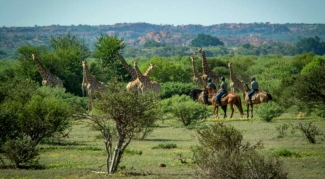
BOTSWANA TULI SAFARI
INDICATIVE ITINERARIES *
TULI 1 SAFARI :
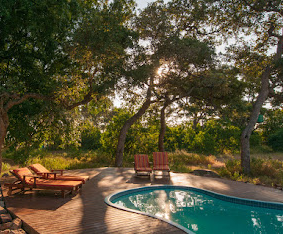 Day 1: RIDE TO TWO MASHATUS CAMP.
Day 1: RIDE TO TWO MASHATUS CAMP.
The Tuli Safari starts on a Saturday, following a flight from Lanseria in South Africa to Limpopo Valley Airfield
in the Mashatu Game Reserve, Botswana. Guest arrive at Johannesburg International airport and are
transferred to Lanseria airport (40 min drive). Guests are received at the Horizon Horseback Mashatu stables
where they will enjoy a light lunch on the banks of the Limpopo River, receive a safety briefing and meet
their horses.
Horizon takes great care to match horse to rider based on a guest’s riding experience and professed ability.
However, before embarking on the safari, each guest will be given a simple riding test in order to ensure
that they are suitably balanced in the saddle and are able to direct their horse in an independent manner.
It is crucially important for the safety and enjoyment of the whole group that riders wishing to book the Tuli
Safari are at least intermediate riders. While the journey is not an endurance test, it does involve long hours
in the saddle and, with the possibility of close encounters with elephant and the big cats, riders need to be
able to gently and confidently control their mounts.
If at this point a rider is unsure of the suitability of their selected horse, a horse swap is possible. At Horizon
Horseback Mashatu, the herd is quite uniform, consisting of well schooled, forward going, but calm horses.
They are mostly boerperd, a beautiful, gentle natured South African breed particularly suited to this type of
work.
The route on this afternoon is from the Stables to Two Mashatus Camp, a distance of 11km. It follows the
Limpopo River floodplains, with good opportunities for those first exciting encounters with elephant, giraffe,
zebra, ostrich and wildebeest. The route crosses close to a large wetland area which acts as a magnet for
game and there is even a chance to come across bat eared fox, black backed jackal and spotted hyena. It
then crosses the Majali River close to its confluence with the Limpopo, a favourite haunt of leopards and a
resident pride of lion. Across an open plain the famous Two Mashatus Camp awaits.
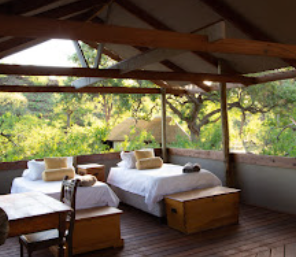 Day 2: TWO MASHATUS TO TREE CAMP.
Day 2: TWO MASHATUS TO TREE CAMP.
The first full day of riding crosses the game rich areas of the central reserve. Following breakfast at dawn,
riders set off first along the Majali and then the Mataboli rivers in a north western arc towards the beautifully
appointed Tree Camp. The route typically yields rich encounters with elephant, waterbuck, giraffe, impala,
wildebeest and zebra. Signs of the many predators that make these rich riverine environments their home
are bountiful, and chance encounters possible. The ride typically takes between four and five hours, and
riders start to form a true bond with their individual mounts. The trappings of modern living begin to fall
away as the sense of adventure and journey deepens.
Tree Camp will be reached in time for a refreshing shower and lunch. After a welcome rest in the comfort
of the camp, nestled in the cooling shade of the majestic Mashatu Tree, a hearty tea will be served. This is
followed by a guided bush walk up the Majali River in search of crocodile and other game. Kudu, warthog,
klipspringer and eland are all present in the area around the camp, as are elephant, lion and hyena.
Waterfowl fly low past the camp and birdsong abounds. This is a truly beautiful place and it is impossible
not to immerse oneself in nature and experience the exceptional qualities of Africa’s wilderness areas.
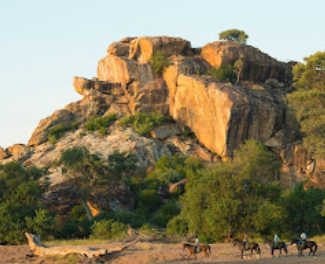 Day 3: VALLEY OF THE ELEPHANTS - TREE CAMP TO KGOTLA.
Day 3: VALLEY OF THE ELEPHANTS - TREE CAMP TO KGOTLA.
Waking in Tree Camp is a magical experience. One feels truly alive, surrounded by birdsong as the early
morning light filters through the majestic tree’s leaves. After a quick breakfast, riders set off on the one of
the journey’s longest rides – up onto the edge of the mini escarpment and then down, through the Valley of
the Elephants and on towards the distant sandstone citadels guarding the Limpopo and Motloutse Rivers.
The first part of the journey is not to be hurried, as the horses wind along well worn elephant paths, past
giant baobabs and the occasional shallow watering pan. Soon, however, the country opens up and the
horses can start to stretch their legs along soft ground leading to the headwaters of a stream flowing off
the ridge and down towards the Limpopo. This is prime elephant country and the guides are always on the
lookout, using all their sharpened senses. Once the path leaves the river, the terrain is once again more
open and the pace faster. A second river is then joined, which leads directly down to the veterinary control
gate on the main road through Mashatu Game Reserve.
The route then follows the road for a short while before heading across flat country towards the intriguing
Sacred Rock massif. Here the mopane vegetation is short and it is safe to ride quite fast across the plain.
Large herds of zebra, wildebeest and impala habit this area. The guides plot their route using individual
mashatu, leadwood and apple-leaf trees as their markers. Soon riders reach the old leadwood enclosure
(used in the past as a traditional law court of a Botswana village) known as ‘The Kgotla’. This open-air
enclosure forms the perfect, secure camp for the night. The camp is not far from the banks of the Motloutse
River and, with high concentrations of game living along the river’s fertile floodplain, the area is home to
large prides of lion and clans of hyena. The sounds of these predators at night provide enduring memories!
In the afternoon, we search for the area’s resident lion on a game drive and draw the day’s adventures
to a close with sundowners at the ancient “Amphitheatre” rocks. Whilst big cat sightings from horseback
occasionally happen, Horizon Horseback follows a ride away policy. The best opportunities to approach lion,
cheetah, leopard and spotted hyena occur whilst on game drives where the vehicle acts as a natural hide
and is largely ignored by the predators. Back at the Kgotla, dinner is enjoyed around a large log fire. The
night is spent with a ceiling of stars and Africa’s night-time melody to sing you to sleep; a veraciously rare
experience which is just about as far away from city life and the modern world as anyone can imagine.
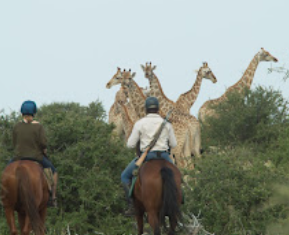 Day 4: EXPLORING THE MOTLOUTSE - Sandstone Cathedrals
Day 4: EXPLORING THE MOTLOUTSE - Sandstone Cathedrals
The riding this day is more relaxed and tailored to the group, since a different camp does not need to be
reached by nightfall. A particularly interesting route to follow is first along the Motloutse River, stopping
at well known elephant drinking holes to watch the herds come and go before winding down towards the
impressive Solomon’s Wall, a tall dolomite dyke which was breached by the river in ancient times. This is
the favourite haunt of troops of baboon, which are always fascinating to watch. The trail then follows the
banks of the river, flanked by giant mashatu and leadwood trees, towards the mighty Limpopo. This area
is renowned for its dramatic sandstone rock formations, steeped in colour and home to eland, klipspringer
and kudu. Some of the oldest civilizations in southern Africa settled in this valley. Archaeological evidence
in the area includes middle and late stone age tools, rock art and the legendary Mapungubwe Dynasty.
Mapungubwe means “Place of the Jackal” in the Venda language and this dynasty existed around 1220 AD.
The Mapungubwe topography itself is ancient and timeless and, combined with marvelous wildlife sightings,
makes for an incredible riding experience.
The game drive in the afternoon takes guests to the foot of the impressive Mamagwa massif, a free
standing formation which was used by British troops as a defensive position against incursions from the
Transvaal Boers at the end of the 19th century. Sundowners are traditionally taken at the far western edge
of the massif, with endless views over the wilderness landscape whilst watching the sun slowly slip over the
horizon. The drive back to Kgotla in the dark provides more excellent opportunities to spot lion, leopard and
hyena.
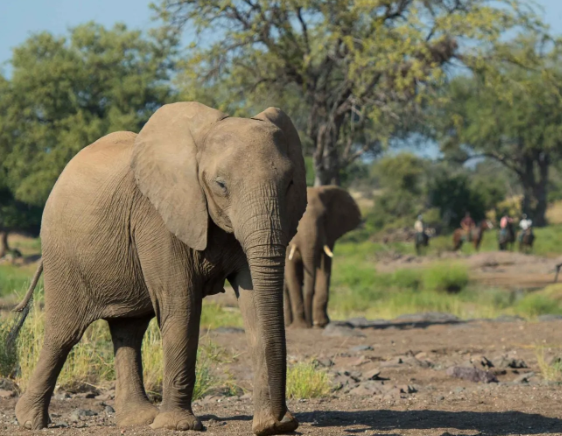 Day 5: RIVER TRAILS – KGOTLA TO TREE CAMP.
Day 5: RIVER TRAILS – KGOTLA TO TREE CAMP.
On this day the journey turns northeast and follows a series of river trails on the way back to the centre of
the reserve. Life in this arid environment is always concentrated near water, and the ride promises sightings
of elephant, zebra, giraffe and wildebeest. The route crosses the watershed and then winds along ancient
paths adjacent to a stream flowing north towards the Majali River. At these elevated heights, the sweeping
views to the north reveal the true wilderness character of Mashatu Game Reserve. Baobab trees scatter the
landscape as they have for centuries, and remarkably two of these giants are found growing directly in the
stream itself. This provides an excellent spot for both horses and riders to stop for a rest and a drink.
The remainder of the day’s riding is a mixture of elephant trail trekking and canters across relatively open
mopane veld. The final stretch is along the Majali River itself, past rocky pools, cliff faces and ribbons of
green grass. Encounters with baboon, kudu, klipspringers and crocodile are likely. Tree Camp is finally
reached after 4-5 hours of riding.
That afternoon guests leave their horses to a well earned rest and will go either on a guided bush walk or,
subject to availability, a game drive with Mashatu Main Camp guides. This opportunity, while provided at
an extra cost, should not be missed as the near guaranteed sightings of lion and leopard, and sometimes
of cheetah, are legendary. The guides are very knowledgeable about the structure and whereabouts of the
various prides and individuals, and failure to find them is very rare indeed.
Day 6: WORLD’S VIEW – TREE CAMP TO TWO MASHATUS CAMP
With an early departure from Tree Camp, this ride offers sweeping views to the east and south, bathed in
early morning light, as it traverses along the edge of a ridge near the centre of the reserve. The path then
descends to a game rich area south of the Majali River. The wetland area are the favourite haunt of baboon
and impala. Sooner or later the great herds of elephant come past for their daily drink, to play in the water
and enjoy a dust bath.
The final part of the ride is first across open plains with some fast canters, and then through cool riverine
vegetation along the approaches to Two Mashatus Camp. This is the original Tuli Trail camp and is
beautifully situated nestled amongst giant mashatu and apple leaf trees close to the banks of the Limpopo
River. This area typically boasts the highest density of elephants in the reserve, who sometimes roam
through the camp in a gentle yet determined way. It is also excellent for lion and leopard as well as baboon,
bushbuck and waterbuck.
Guests sleep in standard safari tents with en suite facilities. After four to five hours in the saddle, this is the
perfect place to relax. On hot days the swimming pool at Two Mashatus is particularly welcoming.
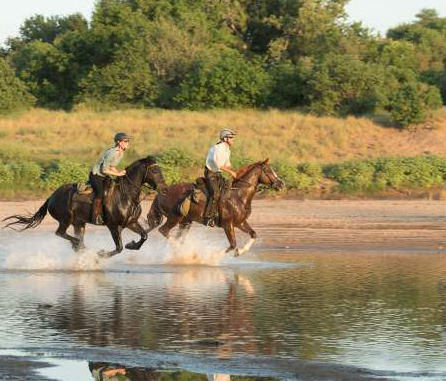 Day 7: OPEN PLAINS– Upriver along the Pitsane River
Day 7: OPEN PLAINS– Upriver along the Pitsane River
This the last full day on Mashatu Game Reserve and the riding explores the game rich area along the
Majali and Pitsani Rivers. In the north there are open plains . Overall the riding is relaxed, with the guides
responding to the herds whilst keeping their eyes peeled for the big cats. In the afternoon there is the option
of a bush walk or a shorter ride, maybe to the banks of the Limpopo River where elephants are often seen
crossing.
Day 8: LIMPOPO FAREWELL – Two Mashatus to the Stables.
The final ride of the Tuli Safari safari is back to the Stables, following the Limpopo River upstream. The route
passes game rich habitat, including a hyena den and a large wetland which can be home to large flocks of
waterfowl. Other notable sightings include Kori Bustard, the largest flying birds in Africa, bat eared foxes and
ostrich.
Once at the Stables it time for a shower and meal on the banks of the great river, and then a short journey
to the Limpopo Valley Airfield for the flight to Johannesburg in South Africa.
Non-Riding Activities:
For those who do not ride a horse, we now have the exciting option of joining the safari on a bicycle. Cycle out each day on one of our Mountain bikes, with our mountain bike guides, before regrouping with the horse riders in your group for meals and sundowners.
* Indicative itinerary
TULI 2 SAFARI :
 Day 1: First Encounters - Ride into Tree Camp.
Day 1: First Encounters - Ride into Tree Camp.
The Tuli 2 starts with a flight from OR Tambo Airport in South Africa to Limpopo Valley Airfield in the Mashatu Game Reserve, Botswana. Guests are received at the Horizon Horseback Mashatu stables where they will enjoy a light lunch on the banks of the Limpopo River, receive a safety briefing and meet their horses. Horizon takes great care to match horse to rider based on a guest’s riding experience and ability. However, before embarking on the safari, each guest will be given a simple riding test in order to ensure that they are suitably balanced in the saddle and are able to direct their horse in an independent manner. It is crucially important for the safety and enjoyment of the whole group that riders wishing to book the Tuli 2 are at least intermediate riders. While the journey is not an endurance test, it does involve long hours in the saddle and, with the possibility of close encounters with elephant and the big cats, riders need to be able to gently and confidently control their mounts. At Horizon Horseback Mashatu, the herd is quite uniform, consisting of well schooled, forward going but calm horses. They are mostly Boerperd, a South African breed particularly suited to this type of work. The route on this afternoon is from the Stables to Tree Camp, a ride of about 2 hours. It rises from the Limpopo River floodplains, with good opportunities for those first exciting encounters with elephant, giraffe, zebra and wildebeest. The route, following ancient elephant paths, winds upwards towards the centre of the Reserve and the upper reaches of the Majali River where the extraordinary Tree Camp awaits.
Day 2: Valley of the Elephants – Tree Camp to Kgotla.
Waking in Tree Camp is a magical experience. One feels fully immersed in nature, surrounded by birdsong, and alive to the new day as the early morning light filters through the majestic tree’s leaves. After a quick breakfast, riders set off on the journey’s first long ride – up onto the edge of the mini escarpment and then down, through the Valley of the Elephants and on towards the distant sandstone citadels guarding the Limpopo and Motloutse Rivers. The first part of the journey is not to be hurried, as the horses wind along well worn elephant paths, past giant baobabs and the occasional shallow watering pan. Soon, however, the country opens up and the horses can start to stretch their legs along soft ground leading to the headwaters of a stream flowing off the ridge and down towards the Limpopo. This is prime elephant country and the guides are always on the lookout, using all their sharpened senses. Once the path leaves the river, the terrain is once again more open and the pace faster. A second river is then joined, which leads directly down to the veterinary control gate on the main road through Mashatu Game Reserve. The route then follows the road for a short while before heading across sandy ground towards the intriguing Sacred Rock massif. Here the mopane vegetation is short and it is safe to ride quite fast across the plain. Large herds of zebra, wildebeest and impala habit this area. The guides plot their route using individual mashatu, leadwood and apple-leaf trees as their markers. Soon riders reach the old leadwood enclosure (used in the past as a traditional law court of a Botswana village) known as ‘The Kgotla’. This open-air enclosure forms the perfect, secure camp for the night. The camp is not far from the banks of the Motloutse River and, with high concentrations of game living along the river’s fertile floodplain, the area is home to large prides of lion and clans of hyena. The sounds of these predators at night provide enduring memories ! In the afternoon, we search for the area’s resident lion on a game drive and draw the day’s adventures to a close with sundowners at the ancient “Amphitheatre” rocks. Whilst big cat sightings from horseback occasionally happen, Horizon Horseback follows a ride away policy. The best opportunities to approach lion, cheetah, leopard and spotted hyena occur whilst on game drives where the vehicle acts as a natural hide and is largely ignored by the predators. Back at the Kgotla, dinner is enjoyed around a large log fire. The night is spent with a ceiling of stars and Africa’s night-time melody to sing you to sleep; a veraciously rare experience which is just about as far away from city life and the modern world as anyone can imagine.
 Day 3: Sandstone Cathedrals – Exploring the Motloutse.
Day 3: Sandstone Cathedrals – Exploring the Motloutse.
The riding this day is more relaxed and tailored to the group, since a different camp does not need to be reached by nightfall. A particularly interesting route to follow is first along the Motloutse River, stopping at well known elephant drinking holes to watch the herds come and go before winding down towards the impressive Solomon’s Wall, a tall dolomite dyke which was breached by the river in ancient times. This is the favourite haunt of troops of baboon, which are always fascinating to watch. The trail then follows the banks of the river, flanked by giant mashatu and leadwood trees, towards the mighty Limpopo. This area is renowned for its dramatic sandstone rock formations, steeped in colour and home to eland, klipspringer and kudu. Some of the oldest civilizations in southern Africa settled in this valley. Archaeological evidence in the area includes middle and late stone age tools, rock art and the legendary Mapungubwe Dynasty. Mapungubwe means “Place of the Jackal” in the Venda language and this dynasty existed around 1220 AD. The Mapungubwe topography itself is ancient and timeless and, combined with marvelous wildlife sightings, makes for an incredible riding experience. The game drive in the afternoon takes guests to the foot of the impressive Mamagwa massif, a free standing formation which was used by British troops as a defensive position against incursions from the Transvaal Boers at the end of the 19th century. Sundowners are traditionally taken at the far western edge of the massif, with endless views over the wilderness landscape whilst watching the sun slowly slip over the horizon. The drive back to Kgotla in the dark provides more excellent opportunities to spot lion, leopard and hyena.
 Day 4: River Trails – Kgotla to Tree Camp.
Day 4: River Trails – Kgotla to Tree Camp.
On this day the journey turns northeast and follows a series of river trails on the way back to the centre of the reserve. Life in this arid environment is always concentrated near water, and the ride promises sightings of elephant, zebra, giraffe and wildebeest. The route crosses the watershed and then winds along ancient paths adjacent to a stream flowing north towards the Majali River. At these elevated heights, the sweeping views to the north reveal the true wilderness character of Mashatu Game Reserve. Baobab trees scatter the landscape as they have for centuries, and remarkably two of these giants are found growing directly in the stream itself. This provides an excellent spot for both horses and riders to stop for a rest and a drink. The remainder of the day’s riding is a mixture of elephant trail trekking and canters across relatively open mopane veld. The final stretch is along the Majali River itself, past rocky pools, cliff faces and ribbons of green grass. Encounters with baboon, kudu, klipspringers and crocodile are likely. Tree Camp is finally reached after 4-5 hours of riding. That afternoon guests leave their horses to a well earned rest and will go either on a guided bush walk or, subject to availability, a game drive with Mashatu Main Camp guides. This opportunity, while provided at an extra cost, should not be missed as the near guaranteed sightings of lion and leopard, and sometimes of cheetah, are legendary. The guides are very knowledgeable about the structure and whereabouts of the various prides and individuals, and failure to find them is very rare indeed.
 Day 5: Deep into the Wilderness – Upriver along the Majali
Day 5: Deep into the Wilderness – Upriver along the Majali
The day’s riding explores an area of the Northern Tuli which is hardly visited by humans. The route at first follows a stream to its source before arcing to the west on high ground and then descending to the upper reaches of the Majali River. It then follows the river all the way back to Tree Camp. This is a relaxed ride during which guests become immersed in the wilderness. There are good opportunities to see elephant, giraffe, zebra, eland and kudu, but it is the sense of being completely away from manmade features that is so compelling on this ride. In the afternoon, there will either be a bush walk or, if it did not happen the previous day, a possible game drive with Mashatu Game Reserve (once again subject to availability).
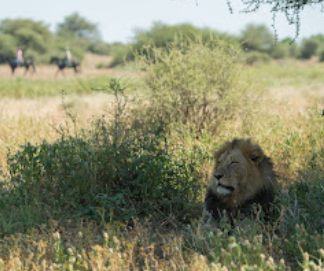 Day 6: World’s View – Tree Camp to Two Mashatus.
Day 6: World’s View – Tree Camp to Two Mashatus.
With an early departure from Tree Camp, this ride offers sweeping views to the east and south, bathed in early morning light, as it traverses along the edge of a ridge near the centre of the reserve. The path then descends to a game rich area along the Majali River. The deep river pools are the favourite haunt of baboon and impala. Sooner or later the great herds of elephant come past for their daily drink, to play in the water and enjoy a dust bath
The final part of the ride is first across open plains with some fast canters, and then through cool riverine vegetation along the approaches to Two Mashatus Camp. This is the original Tuli Trail camp and is beautifully situated nestled amongst giant mashatu and apple leaf trees close to the banks of the Limpopo River. This area typically boasts the highest density of elephants in the reserve, who sometimes roam through the camp in a gentle yet determined way. It is also excellent for lion and leopard as well as baboon, bushbuck and waterbuck. Guests sleep in a frame spacious safari tents with en suite facilities. After four to five hours in the saddle, this is the perfect place to relax. On hot days the swimming pool at Two Mashatus is particularly welcoming.
 Day 7: Open Plains – Upriver along the Pitsane River.
Day 7: Open Plains – Upriver along the Pitsane River.
This the last full day on Mashatu Game Reserve and the riding explores the game rich area along the Majali and Pitsani Rivers. In the north there are open plains . Overall the riding is relaxed, with the guides responding to the herds whilst keeping their eyes peeled for the big cats. In the afternoon there is the option of a bush walk or a shorter ride, maybe to the banks of the Limpopo River where elephants are often seen crossing.
Day 8: Limpopo Farewell – Two Mashatus to the Stables.
The final ride of the Tuli 2 safari is back to the Stables, following the Limpopo River upstream. The route passes game rich habitat, including a hyena den and a large wetland which can be home to large flocks of waterfowl. Other notable sightings include Kori Bustard, the largest flying birds in Africa, bat eared foxes and ostrich. Once at the Stables it time for a shower and meal on the banks of the great river, and then a short journey to the Limpopo Valley Airfield for the flight to Johannesburg in South Africa.
Non-Riding Activities:
For those who do not ride a horse, we now have the exciting option of joining the safari on a bicycle. Cycle out each day on one of our Mountain bikes, with our mountain bike guides, before regrouping with the horse riders in your group for meals and sundowners.
* Indicative itinerary
MEETING:
Air transfers to and from Limpopo are from Johannesburg Lanseria Airport. From Johannesburg airport, you first have a road transfer to Lanseria airport (about 45 minutes), then travel by light aircraft (1h30 flight) from Lanseria airport. The meeting for the transfer is at 11:15, the flight departs at 12:30 pm.
Your flight must arrive in Johannesburg OR Tambo no later than 9:30 am.
DEPARTURE:
For air transfer, the return flight from Limpopo arrives at Lanseria Airport at 4:05 PM. You then have a road transfer to Johannesburg airport OR Tambo arriving around 5pm. Book flights form Johannesburg after 8 p.m.
TRANSFERS:
If you come by rental car: approximately 6 1/2 hours drive from Johannesburg airport. You will have to leave the car at the border, the service provider provides a free transfer (5-10 minutes) to the first camp.
Driving car from/to Johannesburg is not recommended: the journey is tiring and the safari may have to end a little earlier if you are driving.
Deduct 850 € from the price if you arrive directly by car without air transfers.
FLIGHTS:
Flights to/from Johanneburg are not included in our prices because it is generally more interesting to book your flights yourself, an inclusive flight package is generally more expensive with agency commissions. However, we are at your disposal to help you find the best rates: free service.
RIDING ABILITY:
You must be a very good ride, comfortable at the three paces in open spaces (walk, trot, galop) and be able to do small natural jumps when needed. Before each safari, each rider takes a short level test to ensure that they are competent enough to perform the safari, having the level required above. The decision of the test manager is final: if you don't have the required level, an alternative safari may be offered if available. The riding is English style.
GUIDES:
Local guides + English speaking support staff. The guides who lead the safari have many years of experience and most of them grew up in the area and are familiar with the bush. Guides have a professional guide license issued by the Botswana Ministry of Botswana. They are qualified to use firearms and trained in first aid. All rides are supervised by 2 experienced professional guides. The main guide is armed with a rifle and a bull whip. All management staff and guides undergo regular first aid training with a doctor specializing in remote areas. The main guide has a local phone and radio for use in an emergency.
RYTHM:
We cover about 20-30 km daily and spend up to 5.5 hours in the saddle per day.. Long extended canters are a feature of the safari. You will enjoy exploring the differing topography of the area: open bush, wooded riverine areas, wetlands, and strange rock formations home to large baobabs.
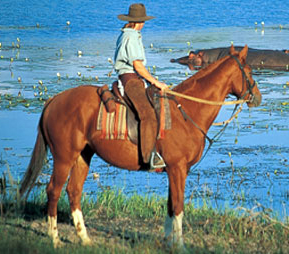 HORSES:
HORSES:
50 well cared for horses, with something to suit everyone including warmbloods, boerpherds, and other cross breeds, ranging from 15 to 17 hands. Safari horses have been hand selected for their endurance, courage and responsiveness. Philosophy has entailed managing our horses as a free roaming herd within large tracts of natural pasture, rather than in stables or paddocks. Horses are at ease with each other and within their environment, which generates calm and contented natures. As a result, we can offer responsive, subtle and honest rides.
TACK: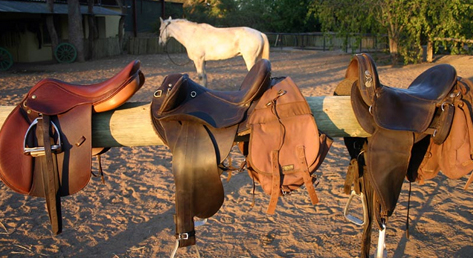
Saddles are South African McClellan’s a military saddle designed for long hours in the saddle. They offer particular comfort and airflow for the horses back and padded seats and fenders for the riders comfort.
INDICATIVE ACCOMMODATIONS:
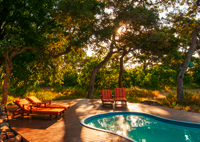 Day 1: Two Mashatus
Day 1: Two Mashatus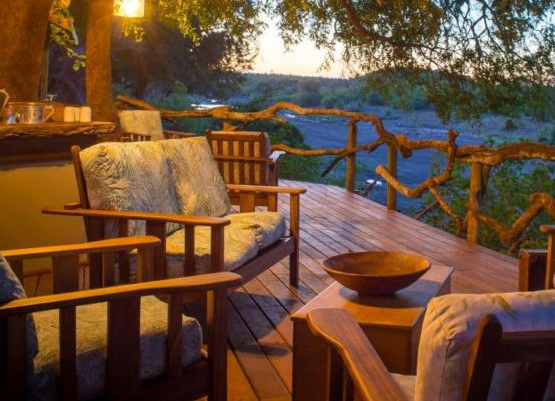 Days 2 & 5: Tree Camp
Days 2 & 5: Tree Camp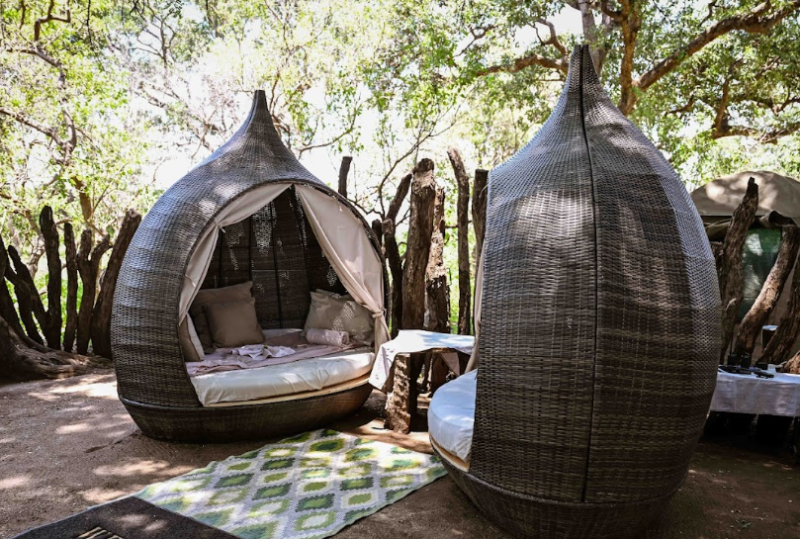 Days 3 & 4: Kgota camp
Days 3 & 4: Kgota camp Days 6 & 7: Two Mashatus
Days 6 & 7: Two Mashatus
Tuli 2:
Days 1 & 7: Two Mashatus
Days 2 & 6: Tree Camp
Days 3,4,5: The Kgotla
- Two Mashatus Camp: Nestled in the shade of a Mashatu tree with two traditionally built Lala palm rondavel dining and lounge areas. Accommodation is in big A-frame walk-in tents pitched on teak platforms with en-suite bathrooms. Each tent is private and positioned in the shade of a tree with a small deck area in front on which to relax during the afternoons. There is also a pool onsite.
- Tree Camp: This is a very unique camp. Nestled in the bough of a giant Mashatu tree and two ancient Leadwood trees, this Seligna deck, 4 meters off the ground, will be your retreat for the night. Two guests each share an airy and cool sleeping pod. Along a short walkway, shared showers and toilets are under the Leadwood trees.
The spacious dining and lounge area flow from the sleeping pods and overlook the Majale River.
- The Kgotla: The Kgotla is an old tribal court from a nearby community, which was relocated to the banks of the Motloutse River on the western periphery of Mashatu. The boma is an open-air traditional African enclosure made up of a circle of Leadwood logs. The camp has hot running water, beautiful open-air showers and flushing toilets (shared): the perfect combination for comfort and an authentic bush experience. Guests sleep on single beds around a large log fire in the center of the enclosure.
Room Occupancy: Triple occupancy is possible, however it may be a bit of a squeeze. If you are willing to share, the single supplement fee does not apply.
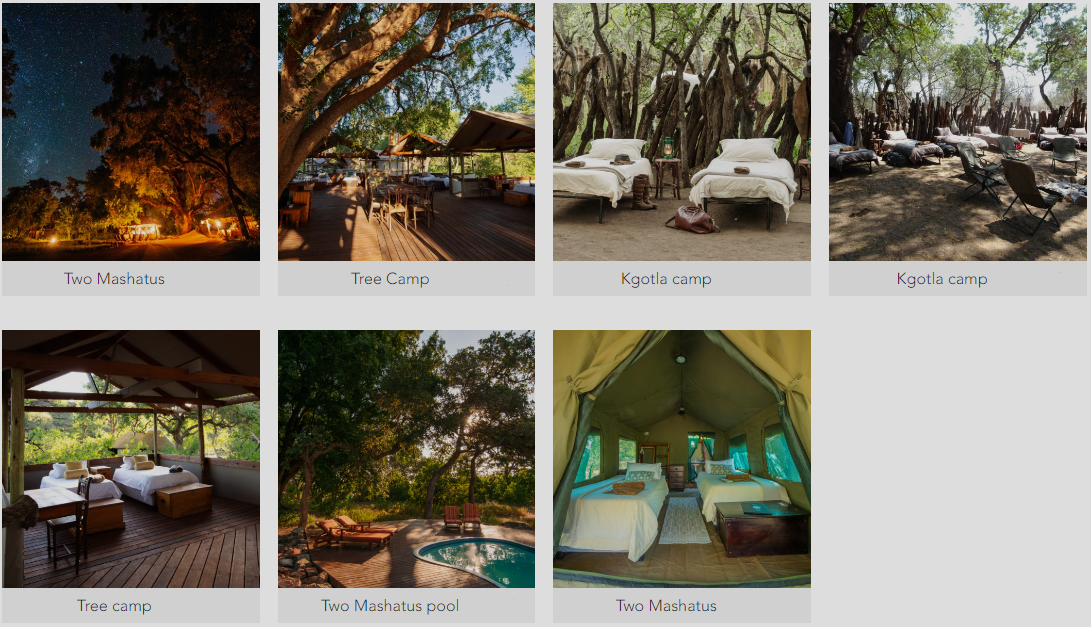
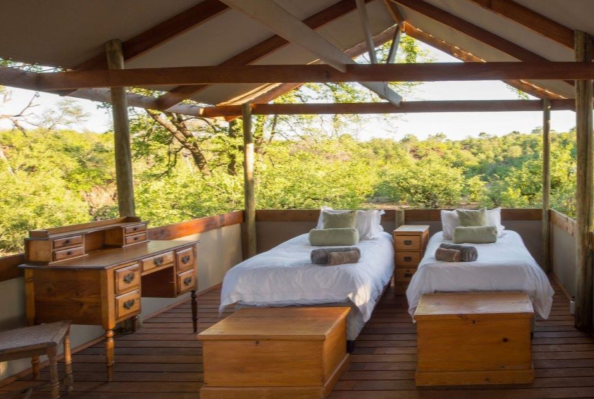
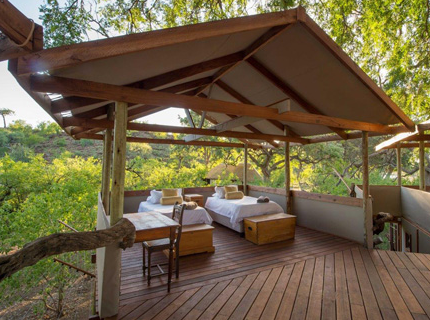
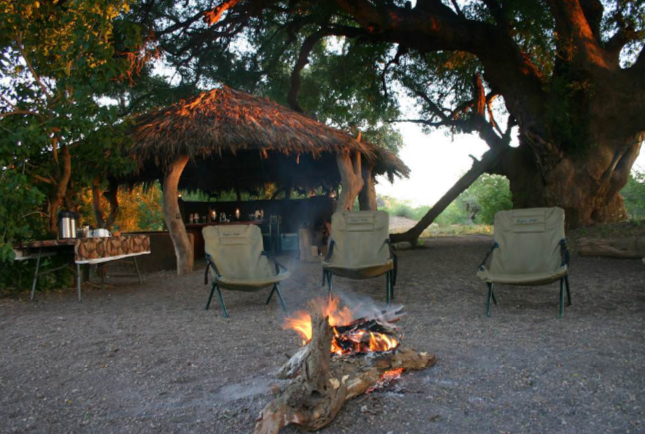
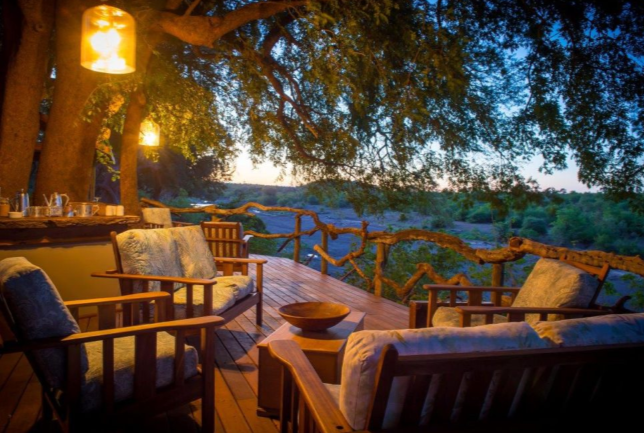
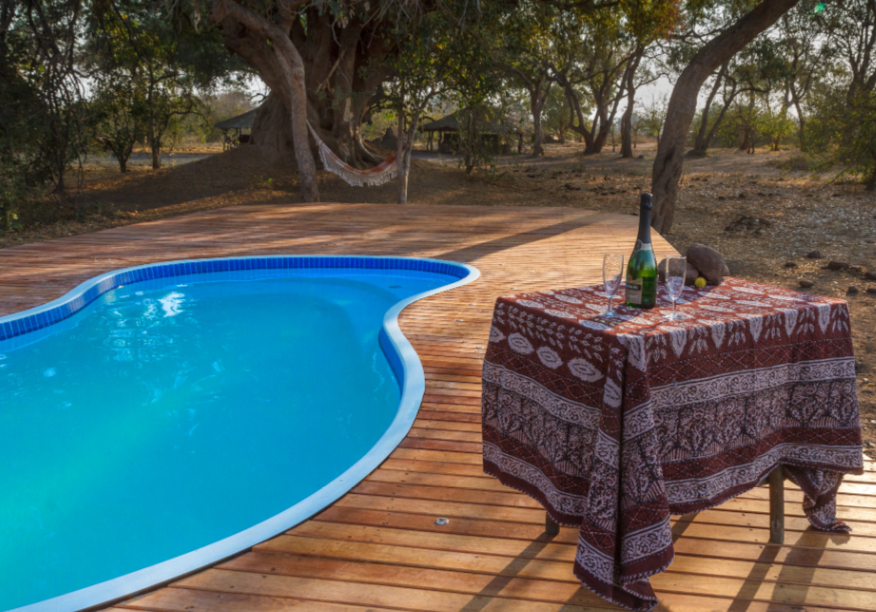
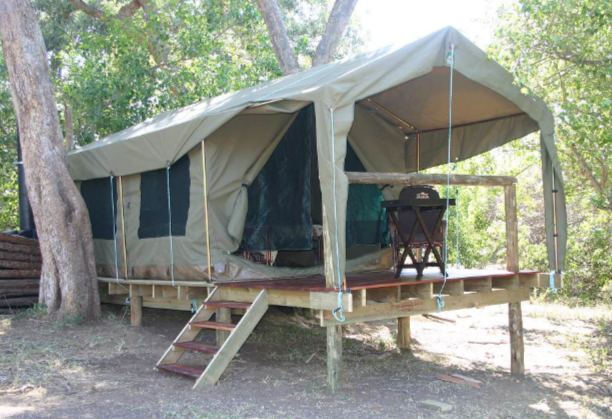
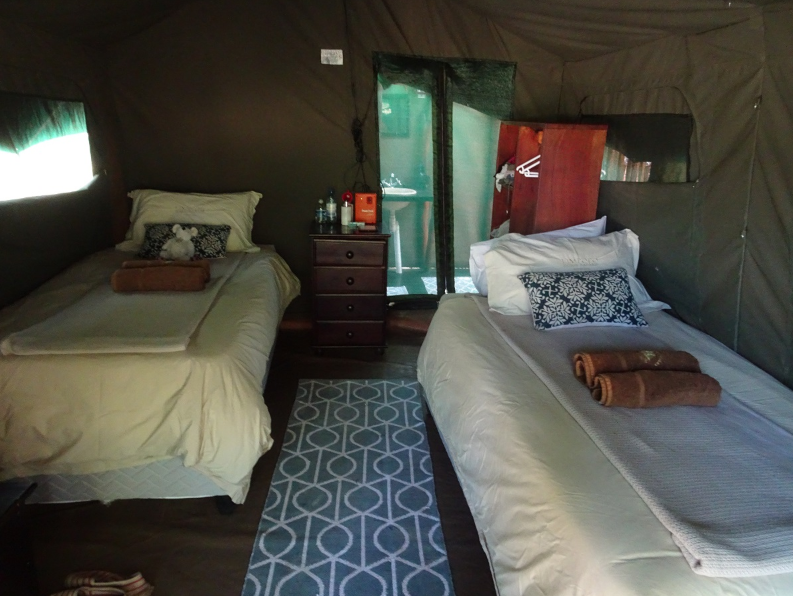
MEALS: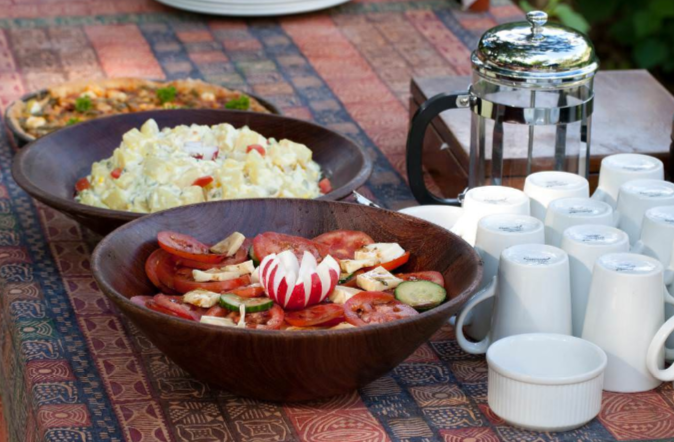
All meals are included in this trip and 2 highly trained experienced bush chefs will look after your every need. Breakfast is buffet of cereals, toast, fruit yoghurt and an egg or other dish (omelets or pancakes or muffins orporridge). Lunch is a buffet eg quiches, salads, and home made breads. Dinner is a 3 course meal served to you at the table, often under the canopy of stars! Vegetarians and other special diets are catered for; please inform us of any special dietary requirements. All water in the camp is filtered to the highest standards and is guaranteed perfectly safe for drinking.
Dietary Restrictions: This trip includes some wine with dinner and can accommodate special dietary requests.
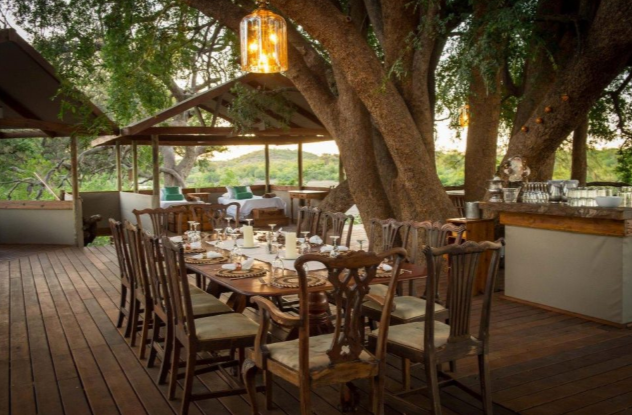
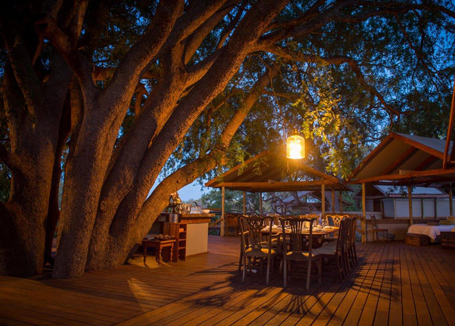
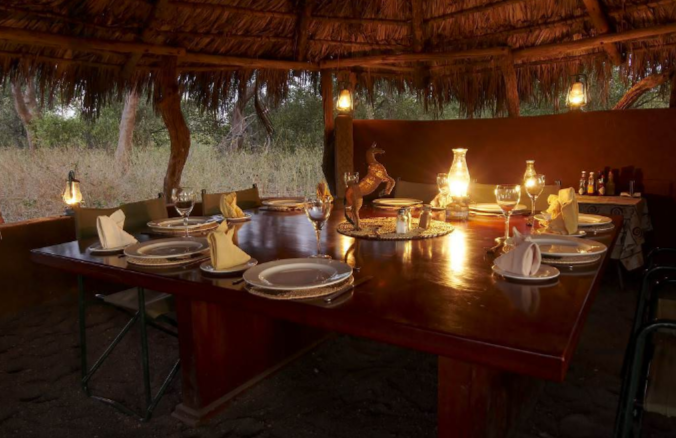
100 € discount for registrations received before 15/01 !
2026 PRICE / PER PERSON:
03/01 to 30/01 & 05/12 to 04/01/2027:
4600 € in 2 person tents.
Single tent supplement: 850 €
31/01 to 27/02:
5300 € in 2 person tents.
Single tent supplement: 1400 €
28/02 to 04/12:
6150 € in 2 person tents.
Single tent supplement: 1670 €
All dates:
Local taxes: 140 US$ / person to be paid locally.
Optional 1st day car safari: 85 US$ / person to be paid locally.
Booking fees: 15 €
* Prices may vary up or down, depending on the change rate & the charter flight prices.
PRICES INCLUDE:
Horse and tack rental, local guides, full board accommodation, all meals, drinks, air transfers from/to Johannesburg, financial bond for your payments by our travel agent guarantee.
PRICES DON'T INCLUDE:
Individual insurance, personal expenses, tips, flights to and from Johannesburg, local taxes: 140 US$ / person to be paid locally, the optional 1st day car safari: 85
INSURANCE:
A civil liability and travel insurance (assistance/repatriation) is compulsory. A cancellation insurance is strongly recommended.
A payment by credit card can make you benefit from its possible insurance (check your contract).
We offer to Europe Union, Switzerland, Liechtenstein, Norway residents: the Chapka insurances.
Cap Security: full insurance with cancellation. Cap Cancellation: cancellation only.
See prices & information
FLIGHTS:
Flights are not included because it is more interesting to book directly your ticket: a transport package included is generally more expensive with agency commissions. However, we are at your disposal to help you find the best prices.
100 € discount for registrations received before 15/01 !
100 € DISCOUNT TO BE DEDUCTED FOR REGISTRATIONS RECEIVED BEFORE 15/12 !
| Dates | From | Infos | Contact |
|---|---|---|---|
| - | 4600€ | TULI 1 - SOLD OUT | Information request |
| - | 4600€ | TULI 1 - SOLD OUT | Information request |
| - | 4600€ | TULI 2 - SOLD OUT | Information request |
| - | 4600€ | TULI 1 - SOLD OUT | Information request |
| - | 5300€ | TULI 1 - LAST SPACES | Information request |
| - | 5300€ | TULI 2 - LAST SPACES | Information request |
| - | 5300€ | TULI 1 - AVAILABLE | Information request |
| - | 5300€ | TULI 1 - AVAILABLE | Information request |
| - | 5300€ | TULI 2 - AVAILABLE | Information request |
| - | 5300€ | TULI 1 - 2 LAST SPACES | Information request |
| - | 6150€ | TULI 1 - SOLD OUT | Information request |
| - | 6150€ | TULI 2 - AVAILABLE | Information request |
| - | 6150€ | TULI 1 - SOLD OUT | Information request |
| - | 6150€ | TULI 2 - LAST SPACES | Information request |
| - | 6150€ | TULI 1 - SOLD OUT | Information request |
| - | 6150€ | TULI 1 - SOLD OUT | Information request |
| - | 6150€ | TULI 2 - LAST SPACES | Information request |
| - | 6150€ | TULI 1 - 2 LAST SPACES | Information request |
| - | 6150€ | TULI 1 - LAST SPACE | Information request |
| - | 6150€ | TULI 2 - LAST SPACES | Information request |
| - | 6150€ | TULI 1 - LAST SPACES | Information request |
| - | 6150€ | TULI 1 - LAST SPACES | Information request |
| - | 6150€ | TULI 1 - LAST SPACE | Information request |
| - | 6150€ | TULI 2 - LAST SPACES | Information request |
| - | 6150€ | TULI 1 - SOLD OUT | Information request |
| - | 6150€ | TULI 1 - LAST SPACES | Information request |
| - | 6150€ | TULI 1 - SOLD OUT | Information request |
| - | 6150€ | TULI 2 - LAST SPACE | Information request |
| - | 6150€ | TULI 1 - LAST SPACES | Information request |
| - | 6150€ | TULI 1 - LAST SPACES | Information request |
| - | 6150€ | TULI 2 - AVAILABLE | Information request |
| - | 6150€ | TULI 1 - LAST SPACES | Information request |
| - | 6150€ | TULI 1 - LAST SPACES | Information request |
| - | 6150€ | TULI 2 - LAST SPACES | Information request |
| - | 6150€ | TULI 1 - LAST SPACES | Information request |
| - | 6150€ | TULI 1 - LAST SPACE | Information request |
| - | 6150€ | TULI 2 - SOLD OUT | Information request |
| - | 6150€ | TULI 1 - SOLD OUT | Information request |
| - | 6150€ | TULI 1 - LAST SPACES | Information request |
| - | 6150€ | TULI 2 - LAST SPACE | Information request |
| - | 6150€ | TULI 1 - SOLD OUT | Information request |
| - | 6150€ | TULI 1 - LAST SPACES | Information request |
| - | 6150€ | TULI 2 - LAST SPACES | Information request |
| - | 6150€ | TULI 1 - LAST SPACE | Information request |
| - | 6150€ | TULI 1 - LAST SPACE | Information request |
| - | 6150€ | TULI 2 - AVAILABLE | Information request |
| - | 6150€ | TULI 1 - LAST SPACES | Information request |
| - | 6150€ | TULI 1 - AVAILABLE | Information request |
| - | 6150€ | TULI 2 - AVAILABLE | Information request |
| - | 6150€ | TULI 1 - LAST SPACES | Information request |
| - | 6150€ | TULI 1 - SOLD OUT | Information request |
| - | 6150€ | TULI 2 - LAST SPACES | Information request |
| - | 6150€ | TULI 1 - LAST SPACES | Information request |
| - | 6150€ | TULI 1 - LAST SPACES | Information request |
| - | 6150€ | TULI 2 - LAST SPACES | Information request |
| - | 6150€ | TULI 1 - AVAILABLE | Information request |
| - | 6150€ | TULI 1 - LAST SPACES | Information request |
| - | 6150€ | TULI 2 - AVAILABLE | Information request |
| - | 6150€ | TULI 1 - AVAILABLE | Information request |
| - | 6150€ | TULI 1 - LAST SPACES | Information request |
| - | 6150€ | TULI 2 - LAST SPACES | Information request |
| - | 6150€ | TULI 1 - LAST SPACES | Information request |
| - | 6150€ | TULI 1 - AVAILABLE | Information request |
| - | 6150€ | TULI 2 - AVAILABLE | Information request |
| - | 6150€ | TULI 1 - LAST SPACES | Information request |
| - | 6150€ | TULI 1 - LAST SPACES | Information request |
| - | 6150€ | TULI 2 - AVAILABLE | Information request |
| - | 6150€ | TULI 1 - AVAILABLE | Information request |
| - | 6150€ | TULI 1 - AVAILABLE | Information request |
| - | 6150€ | TULI 2 - AVAILABLE | Information request |
| - | 4600€ | TULI 1 - LAST SPACES | Information request |
| - | 4600€ | TULI 1 - AVAILABLE | Information request |
| - | 4600€ | TULI 2 - AVAILABLE | Information request |
| - | 4600€ | TULI 1 - LAST SPACES | Information request |
| - | 4600€ | TULI 1 - LAST SPACES | Information request |
| - | 4600€ | TULI 2 - AVAILABLE | Information request |
CLIMATE:
Month | Jan | Feb | Mar | Apr | May | Jun | Jul | Aug | Sep | Oct | Nov | Dec |
Average High Temperature (°F) | 89 | 90 | 88 | 83 | 81 | 76 | 75 | 81 | 87 | 90 | 91 | 90 |
Average Low Temperature (°F) | 69 | 68 | 66 | 59 | 51 | 45 | 44 | 49 | 57 | 64 | 68 | 69 |
Average High Temperature (°C) | 32 | 32 | 31 | 28 | 27 | 24 | 24 | 27 | 30 | 32 | 33 | 32 |
Average Low Temperature (°C) | 21 | 20 | 19 | 15 | 10 | 7 | 7 | 10 | 14 | 18 | 20 | 21 |
Seasons:
Botswana's climate is semi-arid. Though it is hot and dry for much of the year, there is a rainy season, which runs through the summer months. Rainfall tends to be erratic, unpredictable and highly regional. Often a heavy downpour may occur in one area while 10 or 15 kilometers away there is no rain at all. Showers are often followed by strong sunshine so that a good deal of the rainfall does not penetrate the ground but is lost to evaporation and transpiration.
Summer (September to April)
October, November and February are the hottest months! Temperatures in summer can vary from 12 C to 38 C at midday. The rainy season falls in summer, between November and March. In summer during the morning period humidity ranges from 60 to 80% and drops to between 30 and 40% in the afternoon.
Winter (May to August)
This is a period of very little rain, and delightful temperatures by day and refreshingly cool at night. Great time for those who prefer to avoid intense heat or insects. Temperatures during winter months vary from 4 C to 24 C at midday. In winter humidity is can vary between 40 and 70% during the morning and fall to between 20 and 30% in the afternoon.
For tourists, the best visiting months are from April through to October - in terms of both weather and game viewing. It is during this period that the wildlife of the great spaces gather around what water there is - the natural waterholes and the borehole-fed dams - and are at their most visible. However, as the wildlife in this area is not seasonal, wonderful game viewing experiences are possible throughout the year.
